It is also possible to create solid color patterns on the purl side on a striped ground by at first transferring all stitches down to the ribber, then, in turn, using slip stitch selection on the top bed to choose only the stitches that will be manipulated on the main bed. A similar repeat worked on the single bed, may be found in the previous post on Slip stitch patterns with hand transferred stitches, single bed. And a relative, including a double bed version: Bowknot/ Butterfly stitch on the machine, and: A no longer “mystery pattern”.
When working over a striper backing, the color changer is generally in use, and changes happen in even numbers of rows. In my test swatches changes are made every two rows, and whether single or double bed, the color yarn creating the solid color shape needs to not knit while the alternate color is worked only in the background. The held stitches grow in length.
End needle selection is canceled in my samples. 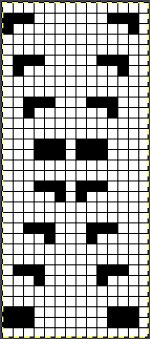 The extra needle selection prior to the next all knit row helps track the direction of the moves, stitches are moved three at a time, there are no cable crossings
The extra needle selection prior to the next all knit row helps track the direction of the moves, stitches are moved three at a time, there are no cable crossings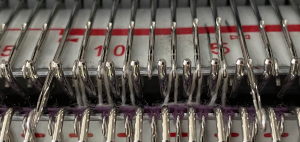
 Things do not always “work”, that is part of the process
Things do not always “work”, that is part of the process 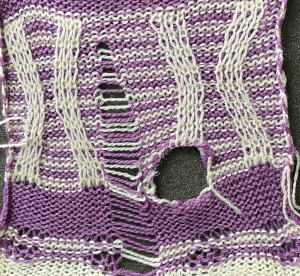
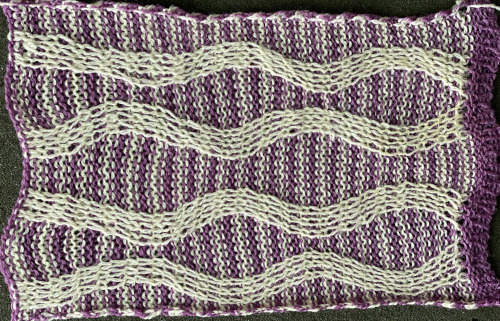 The next step for me was to explore cable crossings on elongated stitches working double-bed. A basic pattern on any programmable machine for playing with elongated stitches on one bed while knitting every stitch on the other is to program pairs of blank rows followed by solid punched or black pixel rows. The yellow line in this chart illustrates the row on which cabling might occur.
The next step for me was to explore cable crossings on elongated stitches working double-bed. A basic pattern on any programmable machine for playing with elongated stitches on one bed while knitting every stitch on the other is to program pairs of blank rows followed by solid punched or black pixel rows. The yellow line in this chart illustrates the row on which cabling might occur. 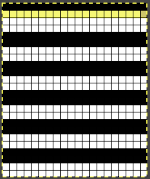 Programming the width of the needle bed allows for only the stitches forming vertical columns in chosen locations to be put into work, allowing one to place groups that will involve crossings anywhere on the chosen pattern width. A base is knit in the ground color, which slips for 2 rows on the main bed, creating the elongated stitches that will be cabled. I had no problem with 2X2 cables,
Programming the width of the needle bed allows for only the stitches forming vertical columns in chosen locations to be put into work, allowing one to place groups that will involve crossings anywhere on the chosen pattern width. A base is knit in the ground color, which slips for 2 rows on the main bed, creating the elongated stitches that will be cabled. I had no problem with 2X2 cables,  but as in working on the single bed, for me, straightforward 3X3 crosses were not cooperative, even when I attempted to introduce extra knit stitches on the sides that were then dropped for added give on the last slipped row, taking me back to the drawing board.
but as in working on the single bed, for me, straightforward 3X3 crosses were not cooperative, even when I attempted to introduce extra knit stitches on the sides that were then dropped for added give on the last slipped row, taking me back to the drawing board. 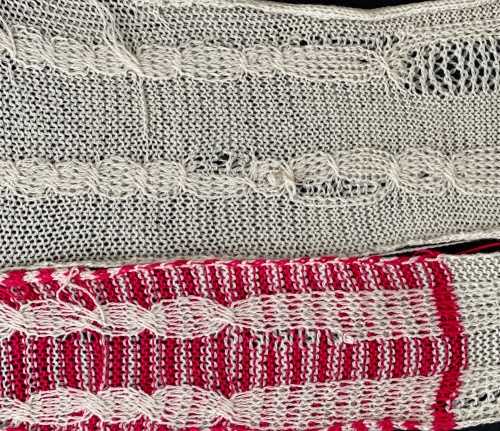 Cabling, returned to in a later post, with adjustments, making things work.
Cabling, returned to in a later post, with adjustments, making things work.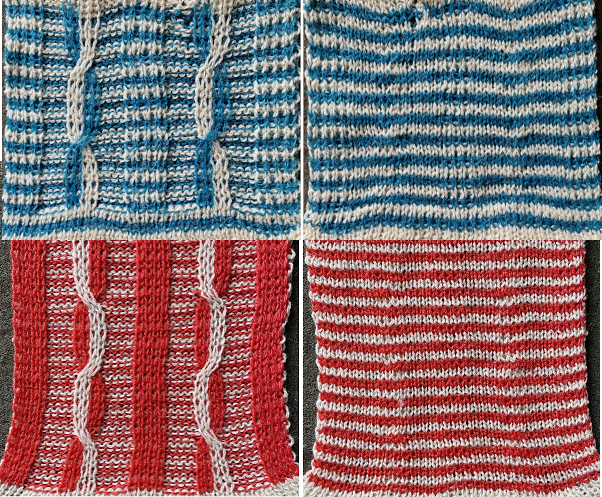 Continuing with shapes on striped grounds, this is the result of a self-drawn pattern
Continuing with shapes on striped grounds, this is the result of a self-drawn pattern  The approach is different than in the blog post on Brother shadow lace, rib transfer carriage, where shapes were created in only one color, and the textured patterns by bringing needles in and out of work on the ribber. To create the striped ground in the above, color changes happen every 2 rows. The ribber knits every needle, every row. With the ribber on half-pitch, the transfers are all made from the main bed needle to the needle immediately below it and slightly to its left.
The approach is different than in the blog post on Brother shadow lace, rib transfer carriage, where shapes were created in only one color, and the textured patterns by bringing needles in and out of work on the ribber. To create the striped ground in the above, color changes happen every 2 rows. The ribber knits every needle, every row. With the ribber on half-pitch, the transfers are all made from the main bed needle to the needle immediately below it and slightly to its left.
In the chart on the left, the green cells represent black pixels that will be programmed for patterning on the top bed, red cells, the stitches on the top bed that need to be transferred down to the ribber on the respective row.
Grey cell rows stand in for all blank ones in the final repeat. 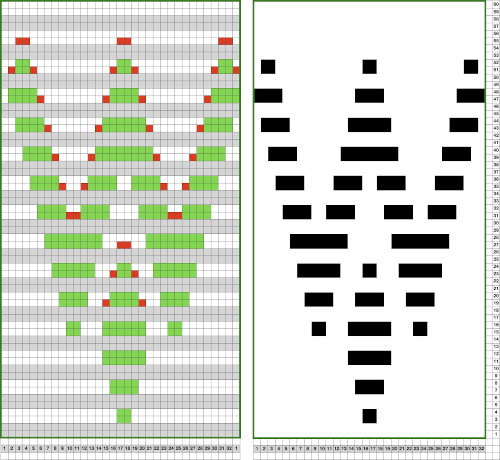 This design is too wide for punchcard machines, but the fabric is possible there as well in different widths, isolated or all over. After casting on, all stitches are transferred to the ribber. Border, plain knit stripes can be added by simply having a larger number of needles in work on the ribber than the planned pattern width. With no needles selected in the pattern on the top bed, those ribber stitches will simply knit every row.
This design is too wide for punchcard machines, but the fabric is possible there as well in different widths, isolated or all over. After casting on, all stitches are transferred to the ribber. Border, plain knit stripes can be added by simply having a larger number of needles in work on the ribber than the planned pattern width. With no needles selected in the pattern on the top bed, those ribber stitches will simply knit every row.
These fabrics are a little different than those with needles out of work on the main bed while using the slip stitch setting, in which case KC II on electronics, end needle selection needs to be turned off on all models. When all needles are in B position, depending on the pattern, KCI may be used. Simply using KCII eliminates any guesswork.
The first preselection row is toward the color changer with the knit carriage set to slip in both directions, only patterned area needles need to be in work. Non-selected needles, as usual, perform no function while those corresponding to where black pixels or punched holes occur will pick up loops on the top bed, initially creating eyelets, and then continue to form knit stitches until any of the corresponding stitches are transferred down to the ribber. The pattern yarn forms a short stitch in one direction, an elongated one in the other. A detailed close-up of stitch formations  Plain striped rows in areas without the design continue to be knit in the slip stitch setting, or every needle in work on the top bed will pick up loops.
Plain striped rows in areas without the design continue to be knit in the slip stitch setting, or every needle in work on the top bed will pick up loops.
When hand manipulating stitches it pays to be mindful of maintaining all needles in the pattern in B position, not accidentally sliding them back to A. ![]() In the past, I have attempted pile knitting on my machines. Studio machines produce the best fabric in the category, I have read Toyota performed as well. Books such as this are a good source for pile designs, including the card repeat used in my proofs of concept
In the past, I have attempted pile knitting on my machines. Studio machines produce the best fabric in the category, I have read Toyota performed as well. Books such as this are a good source for pile designs, including the card repeat used in my proofs of concept 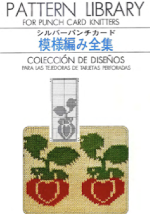 Punchcards, in theory, may be used as given and set to double length, while for use in electronics drawing the pattern single height and using the double-length setting is also an option. Starting sides and fixing errors have always been more confusing for me when using the double-length feature, I prefer to punch holes or program pixels as I intend to knit them. The isolated reduced repeat for use in the electronic is charted, with an initial one-pixel error in 2 consecutive rows, marked with red cells. In transcribing any design, it is worth checking repeats multiple times after eyeballs and brains have had a rest. This was my start:
Punchcards, in theory, may be used as given and set to double length, while for use in electronics drawing the pattern single height and using the double-length setting is also an option. Starting sides and fixing errors have always been more confusing for me when using the double-length feature, I prefer to punch holes or program pixels as I intend to knit them. The isolated reduced repeat for use in the electronic is charted, with an initial one-pixel error in 2 consecutive rows, marked with red cells. In transcribing any design, it is worth checking repeats multiple times after eyeballs and brains have had a rest. This was my start:
![]() The design process using Numbers before exporting the repeat to Gimp for reduction to B/W png: in this approach, the repeat is drawn double height to start with. The red cells represent stitches that will be transferred down to the ribber before knitting the next row in the pattern color from left to right.
The design process using Numbers before exporting the repeat to Gimp for reduction to B/W png: in this approach, the repeat is drawn double height to start with. The red cells represent stitches that will be transferred down to the ribber before knitting the next row in the pattern color from left to right.  The first test is of an isolated motif. The yellow arrow points to the pixel error, the cyan to the positions where some needles in the full repeat were “accidentally” placed in A position, not B, resulting in pattern stitches not being formed.
The first test is of an isolated motif. The yellow arrow points to the pixel error, the cyan to the positions where some needles in the full repeat were “accidentally” placed in A position, not B, resulting in pattern stitches not being formed.  Another review of the original card, a final adjustment in the repeat:
Another review of the original card, a final adjustment in the repeat:![]()
 Tiled view, committing to the result,
Tiled view, committing to the result,  the larger test swatch
the larger test swatch 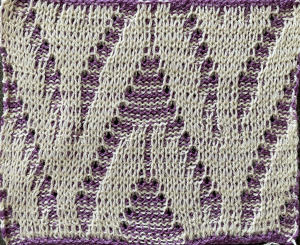 Two other options for charting the fabric in numbers: A. draw the repeat as given
Two other options for charting the fabric in numbers: A. draw the repeat as given
B. starting cell size used was 20X20, change the height to 40
C. mark corner blank cells and screengrab for Gimp import
D. the repeat processed in Gimp matches the first version
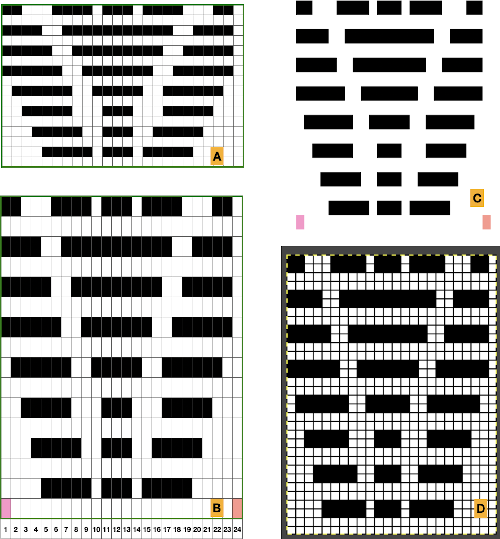 Any simple Fair Isle repeat may also be used. The numbering in the charts matches what is normally seen on the left edge of the tables
Any simple Fair Isle repeat may also be used. The numbering in the charts matches what is normally seen on the left edge of the tables
A. the FI repeat, 8 rows high
B. a table slightly longer than double the repeat height, hide even-numbered rows
C. copy and paste the FI design on the table with hidden rows
D. unhide rows, isolate the repeat, adjust cell height, and continue to process as described above 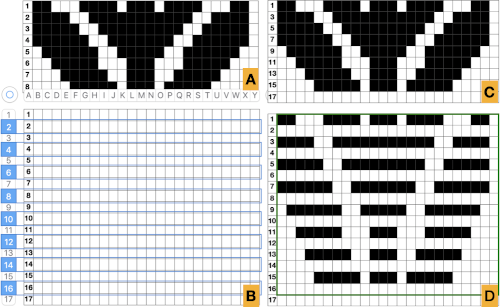
The original punchcard design may be used in a different manner if the goal is a single color fabric. The design may be copied as is, then filling in the blank lines with the same holes or pixels as in the row directly below it. Here, in addition, the repeat is altered to accommodate a half drop repeat on the right with a few pixels changed.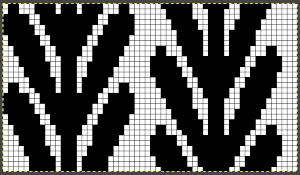
![]() My initial proof of concept is 32 stitches wide, narrower than the full repeat
My initial proof of concept is 32 stitches wide, narrower than the full repeat  The rows need to be scanned before every pass, as transfers to the ribber are not symmetrical due to the shapeshift on the right of the design.
The rows need to be scanned before every pass, as transfers to the ribber are not symmetrical due to the shapeshift on the right of the design.  The world of possibilities grows even further for single color shadow lace, when, examining the same design, one recognizes that the pile knit card, with the blank rows filled in in pattern, is the same as the fair isle version of the repeat, rendered double long
The world of possibilities grows even further for single color shadow lace, when, examining the same design, one recognizes that the pile knit card, with the blank rows filled in in pattern, is the same as the fair isle version of the repeat, rendered double long 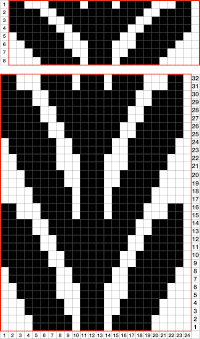
![]() Some authors have suggested plaiting as an alternative to creating shapes with true brioche, which can be complex. To my mind, plaiting falls in the beauty being in the eye of the beholder category, I prefer far crisper color distinction in my knits. This sample from the previous shadow lace post uses thick and thin yarns
Some authors have suggested plaiting as an alternative to creating shapes with true brioche, which can be complex. To my mind, plaiting falls in the beauty being in the eye of the beholder category, I prefer far crisper color distinction in my knits. This sample from the previous shadow lace post uses thick and thin yarns 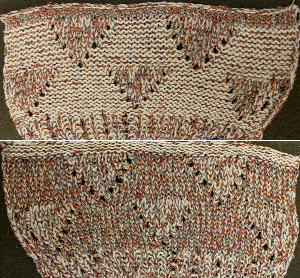 Using the image adapted from the studio pile card once more, I tested using 2 yarns of similar weight, the adjusted test repeat:
Using the image adapted from the studio pile card once more, I tested using 2 yarns of similar weight, the adjusted test repeat: ![]() its accompanying test swatch
its accompanying test swatch 
I have long been interested in pleated knits, both single and double-bed. Working single color or with plaiting makes the repeats easier for DIY designing. Seeking proof of concept for possible “origami” pleating: on the left, yellow marks the spots for transfers to the top bed, which will create folds out toward the knit side. For folds toward the purl side, stitches are manipulated on the ribber, with the final design repeat shown on the right. 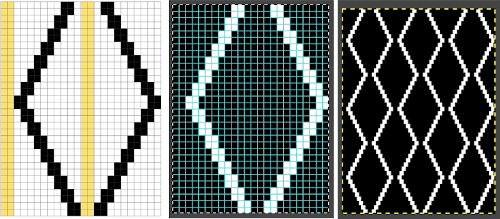
![]() The ribber carriage is set to knit throughout. The needle from which the stitch is transferred to the main bed is moved completely out of work. After the transfer, the main bed needle accepting it is returned to the D position.
The ribber carriage is set to knit throughout. The needle from which the stitch is transferred to the main bed is moved completely out of work. After the transfer, the main bed needle accepting it is returned to the D position.
The knit carriage is set to slip in both directions, end needle selection is canceled. Subsequently, non-selected needles, 1 in the photo, serve as guides for transfers to the ribber, made every two rows. The needles emptied from the transfers need to be maintained in the work, B, position. The selected needles, 2 in the photo, will pick up loops automatically, creating eyelets as seen in previous swatches. 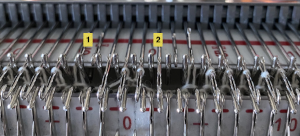 The swatch would have benefited from tighter tension or thicker yarn, the folding effect is greater than reflected in the photo. Initially, those pairs of center stitches were not transferred up to the main bed, showing the absence of that fold when that action is omitted. Any of these patterns benefit from deliberate planning of the placement of the pattern on the main bed, not done in this instance.
The swatch would have benefited from tighter tension or thicker yarn, the folding effect is greater than reflected in the photo. Initially, those pairs of center stitches were not transferred up to the main bed, showing the absence of that fold when that action is omitted. Any of these patterns benefit from deliberate planning of the placement of the pattern on the main bed, not done in this instance. 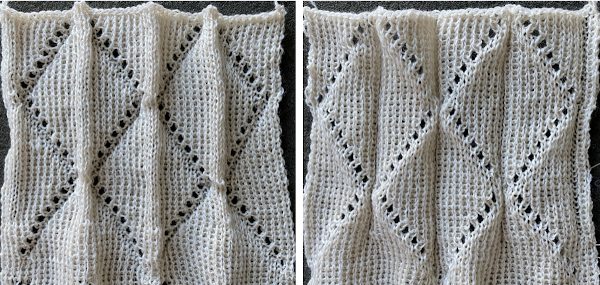 Transitioning to smaller repeats, tiling will help avoid patterning “errors” as seen here where the full diamond shapes reverse
Transitioning to smaller repeats, tiling will help avoid patterning “errors” as seen here where the full diamond shapes reverse 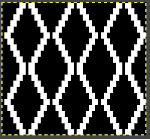
![]()
 Graph paper or spreadsheet planning will help avoid misses in necessary transfers in areas where all needles have been selected
Graph paper or spreadsheet planning will help avoid misses in necessary transfers in areas where all needles have been selected 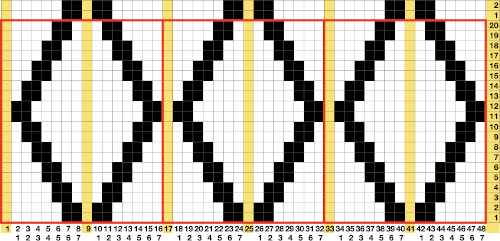 the file for multiple repeats after color reverse
the file for multiple repeats after color reverse 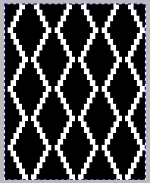
![]() the test knit as using transfers as described above
the test knit as using transfers as described above  and here the empty needles creating the eyelets were filled by picking up the purl bar from the stitch below on the ribber. A lot of work for a change that is not significant in the structure of the fabric.
and here the empty needles creating the eyelets were filled by picking up the purl bar from the stitch below on the ribber. A lot of work for a change that is not significant in the structure of the fabric.  In my last test on eliminating holes and how that affects the degree of the folds, transfers to fill in newly selected needles on the top bed were made from below the adjacent needle on the top bed, B, as opposed to immediately below on the ribber, A
In my last test on eliminating holes and how that affects the degree of the folds, transfers to fill in newly selected needles on the top bed were made from below the adjacent needle on the top bed, B, as opposed to immediately below on the ribber, A 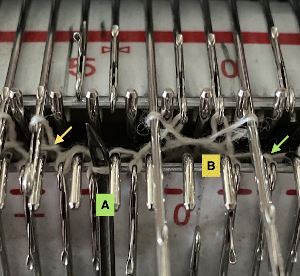 If patterning is used to track transfers, needle selection on the top bed needs to be maintained throughout, the result of this process is not interesting enough and just too fiddly and time-consuming for me to be interested in exploring it further
If patterning is used to track transfers, needle selection on the top bed needs to be maintained throughout, the result of this process is not interesting enough and just too fiddly and time-consuming for me to be interested in exploring it further 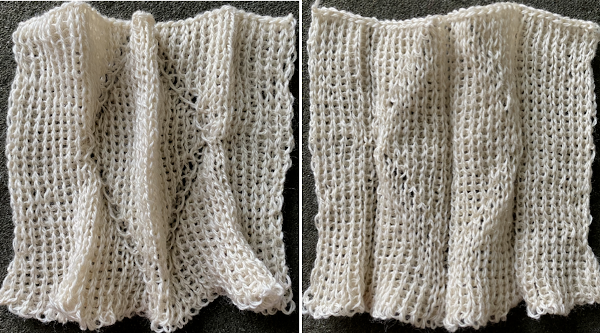 There is an interesting scale and depth of fold comparison between this version and the first using the repeat, achieved by tightening the tension as much as possible, and possibly by reducing the size of the eyelets.
There is an interesting scale and depth of fold comparison between this version and the first using the repeat, achieved by tightening the tension as much as possible, and possibly by reducing the size of the eyelets. 
Exploring manipulations with more than one color patterning on the main bed: there is a type of DBJ that relies on knitting the same color for 2 rows that is inherently different from the KRC built-in separation that is the default in the Japanese model machines. It causes elongation in the design, while the KRC version minimizes it. The differences and methods of the corresponding color separations have been discussed in other posts. Stitch manipulations may occur when working DBJ as well. Simple designs make the best start for beginning to explore the topic 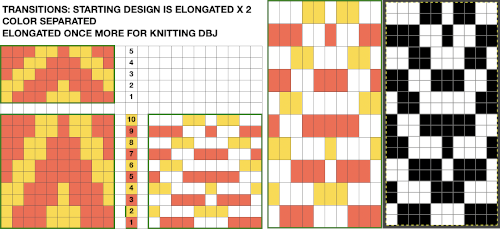 An easy variation is to plan full repeat segments mixed with a striped ground worked only on the ribber
An easy variation is to plan full repeat segments mixed with a striped ground worked only on the ribber  Take care if copying and pasting single columns to alter a repeat width that the whole column is indeed copied and that if using the pencil tool flood fill is not used unintentionally. The original intent was also to correct the elongated slip stitch segments on the edge of the programmed vertical designs marked in blue, but the paste with errors in red accomplished creating the same issue
Take care if copying and pasting single columns to alter a repeat width that the whole column is indeed copied and that if using the pencil tool flood fill is not used unintentionally. The original intent was also to correct the elongated slip stitch segments on the edge of the programmed vertical designs marked in blue, but the paste with errors in red accomplished creating the same issue 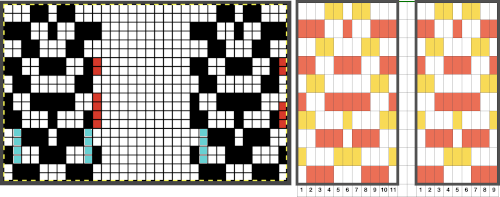
![]() The design is programmed for DBJ. Because of the color separation used, the first preselection row is from right to left. Before knitting the first pattern row, all 10 non-patterning needles on the main bed were transferred down to the ribber.
The design is programmed for DBJ. Because of the color separation used, the first preselection row is from right to left. Before knitting the first pattern row, all 10 non-patterning needles on the main bed were transferred down to the ribber.  The first segments were knit using striper backing, with the ribber knitting every stitch, every row, in both colors. When a slip stitch is used with needles out of work on the main bed, end needle selection should be canceled. In A it was not. The result is that end needles alongside the out-of-work column knit with each color in each row. In B, end needle selection was canceled, and one can now see the elongated slipped stitches that result from areas that should have been marked with the contrasting color
The first segments were knit using striper backing, with the ribber knitting every stitch, every row, in both colors. When a slip stitch is used with needles out of work on the main bed, end needle selection should be canceled. In A it was not. The result is that end needles alongside the out-of-work column knit with each color in each row. In B, end needle selection was canceled, and one can now see the elongated slipped stitches that result from areas that should have been marked with the contrasting color 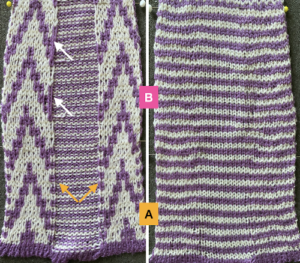 As long as the number of stitches on the ribber is even, lili buttons may be used, affecting the scale of the pattern in both height and width. In A, they were used with the ribber set to slip in both directions, in B, set to tuck in both directions. C marks the return to the N/N setting, with needle transfers to mark a possible pleat.
As long as the number of stitches on the ribber is even, lili buttons may be used, affecting the scale of the pattern in both height and width. In A, they were used with the ribber set to slip in both directions, in B, set to tuck in both directions. C marks the return to the N/N setting, with needle transfers to mark a possible pleat. 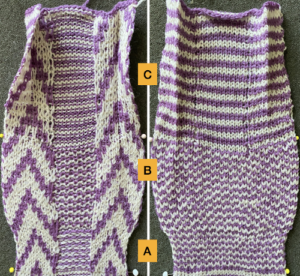 The initial pleat idea charted out for single stitch folds, stitches transferred to ribber in the R columns, to the top bed in the T columns
The initial pleat idea charted out for single stitch folds, stitches transferred to ribber in the R columns, to the top bed in the T columns 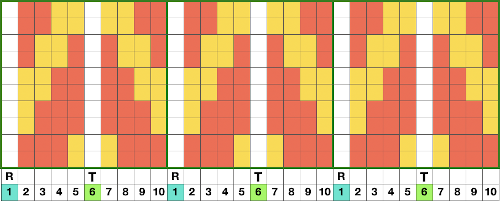 The result is a fairly soft pleat, the choice below was to retain end needle selection.
The result is a fairly soft pleat, the choice below was to retain end needle selection. 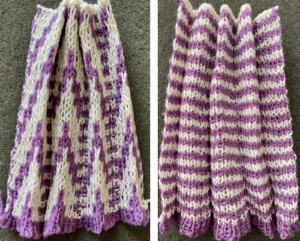 Various ribbed pleat configurations are explored in Pleats: ribbed, folding fabrics. This repeat may not be the best to use for a variety of reasons, but experimenting while using the same design and yarns can be useful in understanding stitch formations. Theoretically, the alternating direction of folds should create sharp or knife pleats.
Various ribbed pleat configurations are explored in Pleats: ribbed, folding fabrics. This repeat may not be the best to use for a variety of reasons, but experimenting while using the same design and yarns can be useful in understanding stitch formations. Theoretically, the alternating direction of folds should create sharp or knife pleats.  Paired transfers in the planning stages: because the repeat is small and has a single center pivot point, it is rendered once more, adding columns
Paired transfers in the planning stages: because the repeat is small and has a single center pivot point, it is rendered once more, adding columns
![]() Here the transfers planned to opposite beds are marked on a 48 stitch repeat with red cells.
Here the transfers planned to opposite beds are marked on a 48 stitch repeat with red cells.
 The resulting fabric relaxed on the left, lightly steamed on the right
The resulting fabric relaxed on the left, lightly steamed on the right 
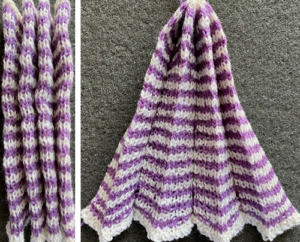 Note: the color positions in the design have been reversed from those in the first swatch. If “floats” are noted at any time in the spaces where needles are out of work on the ribber, look for dropped stitches.
Note: the color positions in the design have been reversed from those in the first swatch. If “floats” are noted at any time in the spaces where needles are out of work on the ribber, look for dropped stitches.
Vertical bands of color, even in patterns may be transferred to and from beds to achieve a sort of intarsia effect. One option is to work with vertical bands of fixed color, using the KRC built-in separation. When shifting gears it is useful to remember the starting side for the preselection of the first row of patterns. With many of the previous patterns, designed for color changes every 2 rows, starting side was on the right, toward the color changer. With KRC in use, the first preselection row is away from the color changer on the left, moving toward the right. With either method, starting on the wrong side will knit stripes as opposed to planned patterns. ![]()
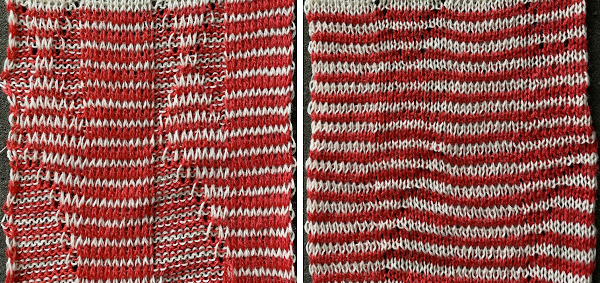 Needles in locations where only the backing is to be shown are transferred down to the ribber. Leaving the eyelets, they were transferred back up to the main bed when brought into work to reverse or change the shape. Addition and subtraction of stitches take place before the next pass with the alternate color. Here movement is random, to get some sense of the effect, it could be made deliberate by following a chart or color separating and automating the pattern, with its starting side on the right.
Needles in locations where only the backing is to be shown are transferred down to the ribber. Leaving the eyelets, they were transferred back up to the main bed when brought into work to reverse or change the shape. Addition and subtraction of stitches take place before the next pass with the alternate color. Here movement is random, to get some sense of the effect, it could be made deliberate by following a chart or color separating and automating the pattern, with its starting side on the right. 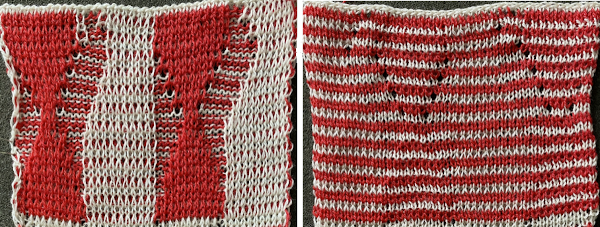 This sample is from a much earlier post. Transfers could be made less frequently to change the angles in the resulting shapes, always onto the same color
This sample is from a much earlier post. Transfers could be made less frequently to change the angles in the resulting shapes, always onto the same color  What of having shapes appearing in each of the 2 colors on a striped ground? Eliminating some of the guesswork I used the repeat from a previous single-bed blog post on block slip stitch color separations
What of having shapes appearing in each of the 2 colors on a striped ground? Eliminating some of the guesswork I used the repeat from a previous single-bed blog post on block slip stitch color separations  The repeat, 32X44
The repeat, 32X44![]()
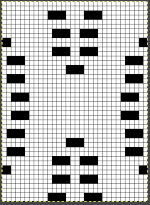 The resulting sample, the yarn is thin, might have benefited from tighter tension and more contrast.
The resulting sample, the yarn is thin, might have benefited from tighter tension and more contrast. 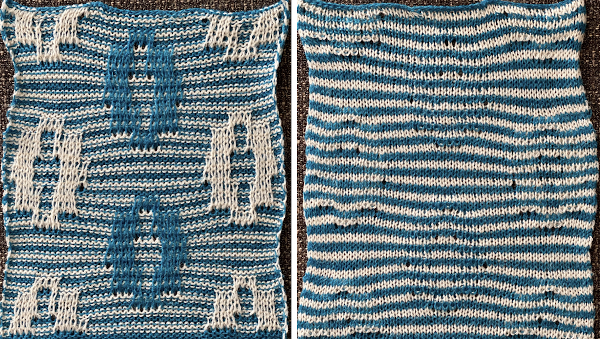 These fabrics and related shadow lace ones fall in the category of double bed embossed patterns, many more variations are possible, and deserving of their own post.
These fabrics and related shadow lace ones fall in the category of double bed embossed patterns, many more variations are possible, and deserving of their own post.